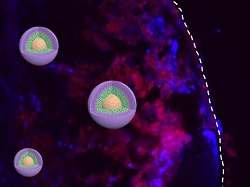 |
| Optimally sized nanoparticles show the highest tissue retention (red)--Courtesy of U. of Illinois |
The optimal size of nanoparticles is 50 nanometers, smaller than the 100- to 200-nm ones deployed today, concludes a study by University of Illinois researchers.
"Over the last 2-3 decades, consensus has been reached that particle size plays a pivotal role in determining their biodistribution, tumor penetration, cellular internalization, clearance from blood plasma and tissues, as well as excretion from the body--all of which impact the overall therapeutic efficacy against cancers," said MIT postdoctoral fellow Li Tang, formerly of the University of Illinois, in a release. "Our studies show clear evidence that there is an optimal particle size for anticancer nanomedicines, resulting in the highest tumor retention."
The team tested 20-nm, 50-nm and 200-nm monodisperse drug-silica nanoconjugates. Properties other than size were held constant. The 50-nm nanoparticles showed efficacy against in vivo primary and metastatic tumors, displaying the abilities mentioned by Tang, such as deep tumor tissue penetration, efficient cancer cell internalization and slow tumor clearance.
The research adds to the growing desire to make smaller nanoparticles for drug delivery. "There has been a major push recently in the field to miniaturize nanoparticle size using novel chemistry and engineering design," said University of Illinois materials science professor Jianjun Cheng in the release.
As an example of that push, in August, Johnson & Johnson's ($JNJ) Janssen pharmaceuticals unit acquired drug delivery specialist Covagen, developer of a class of binding proteins known as fynomers. Weighing 7 kilodaltons, fynomers are smaller than antibodies but can be designed to bind target molecules with the same affinity and specificity as antibodies, according to the company's website.
Covagen has a compound in Phase I for the treatment of inflammatory diseases. It consists of a fynomer fused to a human antibody.
More details of the nanoparticle size study are available in the Proceedings of the National Academy of Sciences.
- read the university news release
- here's the study abstract in PNAS